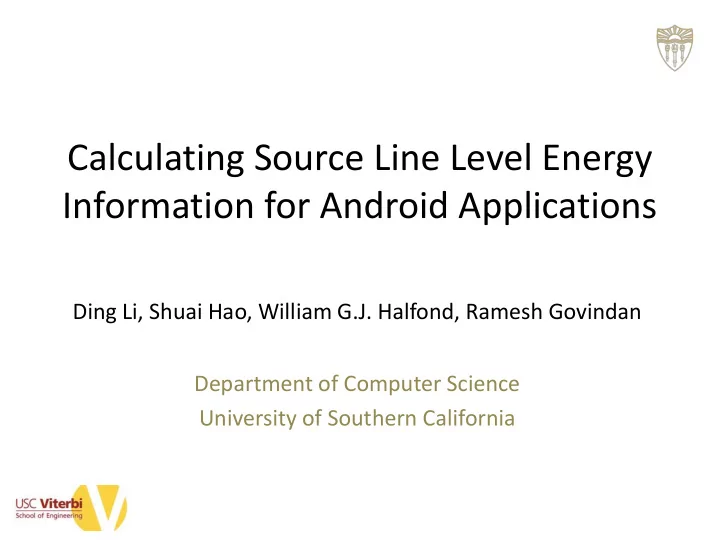

Calculating Source Line Level Energy Information for Android Applications Ding Li, Shuai Hao, William G.J. Halfond, Ramesh Govindan Department of Computer Science University of Southern California
Motivation: App Energy Consumption • Battery power is limited on smart phones • Developers lack fine-grained energy feedback • Other approaches have critical limitations 1
Direct Measurement Measure with power meters – Does not sample fast enough • 10 KHz vs. 1GHz – Cannot detect runtime events • Thread Switching • Garbage Collection (GC) Does not provide source line level information 2
Other Approaches • Cycle-level simulators – Cannot run market apps realistically • Model on OS features – Does not provide source line level granularity • Estimate energy with models and runtime information, for example, eLens – Building a good model is expensive 3
Road Map of Problem Solving Challenge Solution Measure instead of Expensive model modeling Insufficient sampling Isolate source line speed energy with regression Account for runtime Path information events analysis Capture runtime Efficient Instrumentation information 4 4
Architecture of vLens Runtime Offline Analysis Phase Measurement Phase 5 Annotated Annotator Code 4 1 Energy App Insufficient App Analyzer Report Instrumenter data? App ′ 3 2 Power Path Test Measurement Path Adjuster Cases Energy Platform 5
1. App Instrumenter Add probes to record runtime information • Record the execution path – Efficient Path Profiling [Ball & Larus] • The entry and exit time of APIs – Instrument APIs 6
2. Power Measurement Platform Run apps and collect energy and path information • LEAP: run the app – Atom N550 platform – Runs Android x86 3.2 • DAQ: measure the energy – Samples at a high frequency – Synchronizes time stamps to LEAP – Multiple components: CPU, RAM, WIFI, GPS 7
3. Path Adjuster Handle problematic energy costs prior to regression analysis • Calculate energy of API calls • Assign tail energy to corresponding API calls – Tail Energy: energy caused by an API but expended after return of the API • Distribute energy among concurrent internal threads 8
3. Path Adjuster: API Energy Calculation Calculate and remove non-linear API cost Sum up energy between entry and exit time stamps 𝑢2 − 𝑢1 𝑢4 − 𝑢3 𝐹 𝑢3,𝑢4 Minimal sampling interval 9
3. Path Adjuster: Tail Energy Assign tail energy to corresponding API 𝑈𝐹 𝐵𝑄𝐽_1 = 𝑈 𝑡 𝐵𝑄𝐽_2 − 𝑈 𝐹 (𝐵𝑄𝐽_1) 𝐹 𝑢𝑏𝑗𝑚 𝑈 𝑢𝑏𝑗𝑚 10
3. Path Adjuster: Internal Multi-thread Split energy among concurrent internal threads 1 𝐹 𝑈1 = 𝐹 𝑢1,𝑢2 + 1 2 𝐹 𝑢2,𝑢3 + 1 2 𝐹 𝑢2,𝑢3 3 𝐹 𝑢3,𝑢4 11
4. Analyzer Calculate source line level energy information • Distribute energy to bytecodes – Use robust regression techniques • Eliminate GC and external thread switching – Residual-based outlier detection 12
4. Analyzer: Robust Regression 𝜒(𝑧 𝑗 − 𝑦 𝑗𝑙 𝜄 𝑙 )𝑦 𝑗𝑘 = 0 𝑗 𝑙 Iterative 𝜒 𝑙 = 𝑦(𝑙𝜏 − 𝑦 2 ) 2 , −𝑙𝜏 < 𝑦 < 𝑙𝜏 0 , 𝑝𝑢ℎ𝑓𝑠𝑥𝑗𝑡𝑓 13
5. Annotator 14
Evaluation RQ1: What is the time cost of our approach? RQ2: How accurately can our approach calculate the energy consumption of apps? 15
Apps for Evaluation All of our apps are from the Google Play app market App information App #Classes #Methods #Bytecodes BBC Reader 590 4,923 293,910 Bubble Blaster II 932 6,060 398,437 Classic Alchemy 751 4,434 467,099 Skyfire 684 3,976 274,196 Textgram 632 5,315 244,940 16
RQ1: Analysis Time Cost Pre-execution In-execution Post-execution Runtime Path & regression Efficient path profiling overhead: 4% analysis time: instrumentation time: 1.97 min 7.5 min 17
RQ2: Accuracy 1. API energy measurements 2. Bytecode energy distribution DAQ cannot get source line level information – Application level – Path level 3. GC and thread switching detection 18
Accuracy of the API Energy Measurements The average difference is 9% 24 APIs represent 70% of total API energy 19
Accuracy of Bytecode Energy Distribution • R 2 :Path level – Well used statistical metric – Describe the quality of regression model • AEE: Application level accuracy – Difference between the result from our model to the measured ground truth 20
Accuracy of Bytecode Energy Distribution vLens is accurate on both application level and path level Accuracy App R 2 AEE (%) BBC Reader 0.94 6.5 Bubble Blaster II 0.90 8.6 Classic Alchemy 0.93 3.4 Skyfire 0.99 4.8 Textgram 0.92 6.3 21
Accuracy of Outlier Detection • Detect outliers caused by GC and external thread switching • Cannot capture real GC and external thread switching • Seed GC and thread twitching at random positions per app – 200 System.gc() – 200 Thread.start() and Thread.join() BBC Reader Bubble Blaster II All seeded events are identified by Classic Alchemy outlier detection Skyfire Textgram 22
vLens: Calculating Source Line Level Energy Consumption • Combines program analysis and statistical analysis • High accuracy – 9% error • High granularity – On source line level • Low overhead 23
Thank you 24
Definition of AEE and R 2 25
Bytecode Profiling load a load a add = load b load b - add pop pop 26
vLens vs. eLens • vLens: – Have energy measurement equipment – No model – Needs to handle run time events, such as GC, external thread switching, concurrent app thread • eLens: – No energy measurement equipment – Needs to build model – Does not need to handle run time events. 27
Recommend
More recommend